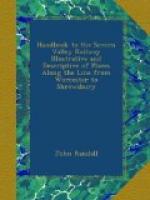Is forty-three miles from Worcester, and eight and a half from Shrewsbury. The name is an abbreviation of Christsache, ache been the old Saxon term for oak. The folk-lore of the district is, that the old tree was one under which the early Christian missionaries preached, that it stood in the centre of the village, and that upon its decay it was supplanted by a market cross, which cross itself has disappeared. Our engraving represents another of these venerable trees standing a quarter of a mile from the village, known as the Lady Oak.
[The Nddel’s Eye: 37.jpg]
Before the railway caused a deviation in the road, it stood by the wayside, where it was regarded with veneration by the inhabitants, who cramped it with iron, and propped it with blocks of wood to preserve it; they also planted an acorn within its hollow trunk, from which, as will be seen by our engraving, a young tree mingles its foliage with that of the parent oak. About a mile from Cressage is Belswardine, the seat of Sir George Harnage, an old border estate, in possession of the same family which received it from the Conqueror. Cressage station is the nearest and most convenient on the Severn Valley line from which to reach the Wrekin. The distance is three miles. The road crosses the river by an ancient wooden bridge, and at Eaton Constantine passes the house in which Richard Baxter lived when a boy; and which the great Puritan divine describes as “a mile from the Wrekin Hill.” The visitor, in his ascent of the hill, passes a conical knoll of deep red syenite, clothed with verdure, and known as Primrose Hill. The summit is 1,320 feet above the level of the sea, and commands a prospect embracing a radius of seventy miles. Our engraving represents a severed cliff of greenstone at the top, called the Needle’s Eye, and which tradition alleges to have been riven at the Crucifixion. Near it is a culminating boss of pinkish felspar known as the Bladder Stone, a name derived, it is supposed, from Scandinavian mythology; whilst at a short distance is the Ravens’ Bowl, a basin in the hard rock, always containing water. On its sides are stratified rocks which the trap has pierced in its ascent; and which, by the action of heat, have been changed into a white crystalline substance. At the northern termination is an entrenched fortification called Heaven Gate, supposed to be of British origin; and near it is another, called Hell Gate, with what is supposed to be a tumulus. In the valley at the foot of the hill, on the eastern side, tumuli have been opened, in which hundreds of spear heads and other broken weapons have been found. Here formerly,
“Unknown to public view,
From youth to age a reverend hermit
grew.
The moss his bed, the cave his humble
cell,
His food the fruit, his drink the
crystal well.
Remote from man, with God he passed
his days,
Prayer all his business—all
his pleasure praise.”




